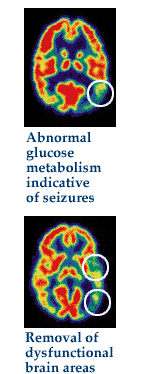| PET Scan For » Brain Disorders |
|
|
 |
How Can PET Make a Difference?
Nothing conjures up so much dread in the elderly as a
diagnosis of Alzheimer's disease. Nothing is more
heartrending than to see a child with an uncontrollable
seizure disorder. To share a moment with a victim of
Parkinson's disease is to witness the agony of not being
able to perform the simplest of physical tasks. Stroke,
dementia in its many forms and brain tumors are other
disorders that strike the brain and the very core of our
personality.
PET is proving valuable for patients with these neurological
disorders. CT and MR scans may render exquisite detail about
the structure of the brain, but cannot determine anything
about its function. With a single PET scan image,
abnormalities of brain function can be found that would
otherwise go undetected.
- PET can determine if the cause is Alzheimer's disease,
blood flow shortages, depression, or some other reason.
- PET can localize the brain site of seizure activity.
This is especially important for children with
uncontrollable seizures who are candidates for surgery as
a cure.
- PET can tell if that muscle tremor is Parkinson's
disease or another of the "Movement" disorders.
- PET can look at a brain tumor and reveal if it is
benign or malignant. It is also widely used when
recurrence is suspected to show whether structural change
is tumor re-growth or merely scar tissue.
- PET can "map" the areas of the brain responsible for
movement, speech and other critical functions. This is a
remarkable guide for surgeons who are performing delicate
operations on different areas of the brain.
|
| Brain cells use
glucose as fuel, and the more active the brain cells
are, the more they will consume radioactive glucose (FDG).
Using absorption data, a computer can show the levels of
brain activity as a "color coded brain map" (PBS.org).
One color (usually red) indicates more active brain
areas and another color (usually blue) indicates less
active areas. |
|
|
|
|